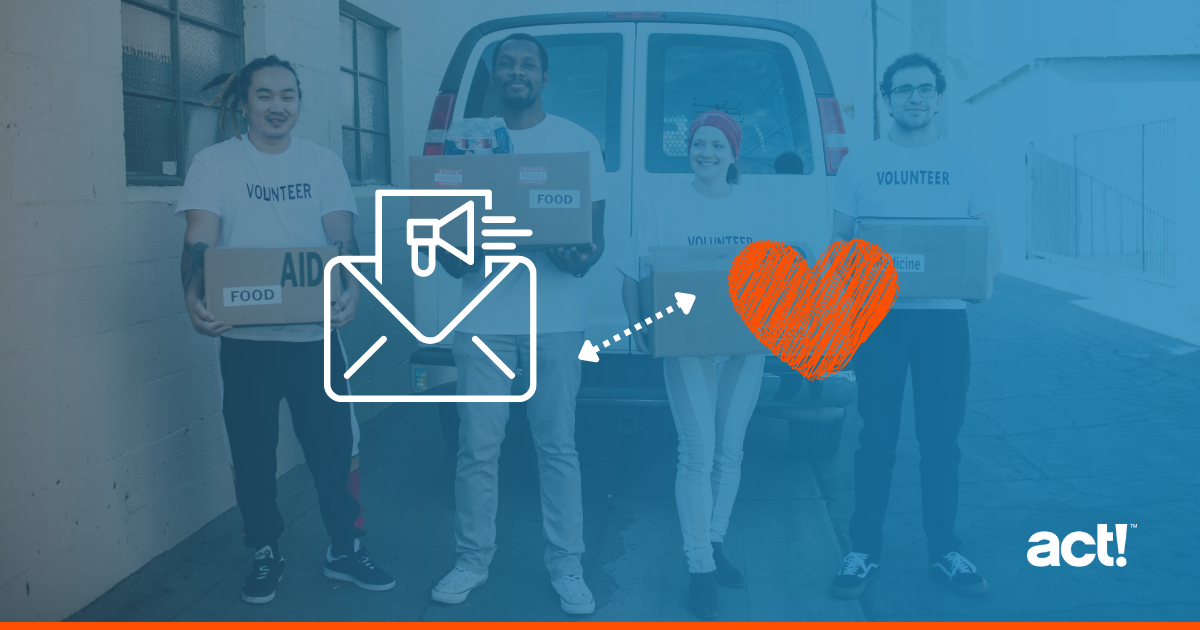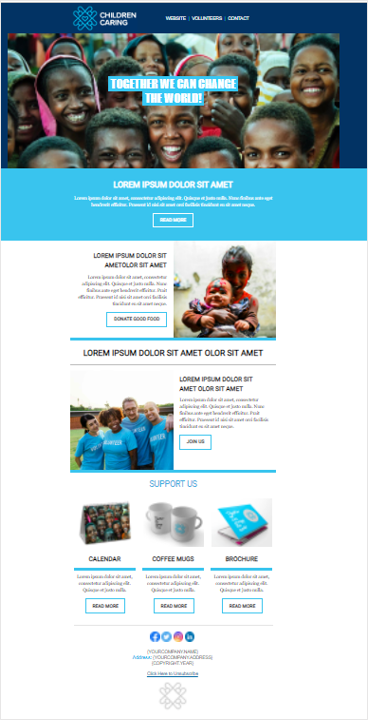
It can be tempting to think an email marketing strategy is outdated and irrelevant. Some may say that nonprofits should focus more on upping their social media game to reach younger audiences. Of course, there’s no need to prioritize one over the other because a multi-channel marketing strategy is important for any organization. And, believe it or not, email is still an essential part of that mix.
Here’s why:
- According to the 2020 Global Trends in Giving Report, 26% of online donors say that email is the communication tool that most inspires them to give.
- , which is especially important in cost-conscious nonprofit organizations.
- Email is an easy way to reach your specific supporters, especially older generations who may be less active on social media platforms.
- Email can be highly personalized and targeted to specific groups, such as your donor base, volunteers, and event attendees.
- Email provides useful metrics and feedback about how contacts are engaging with your messaging.
How to build (or boost) your email marketing foundation
If you want to improve the results you get from email marketing campaigns, now’s the time to do some housekeeping. Here are a few things to consider:
Grow your contact list organically.
Don’t be tempted to buy a nonprofit mailing list as a shortcut to building up your contacts. You’ll see better results when you attract audiences who are truly interested in your mission. Purchased mailing lists almost always include people who have no connection to or interest in your organization, which creates a bloated database you eventually have to clean up and can put your sender reputation at risk.
Clean up your old contact list.
Remember: quality is more important than quantity. It’s never a bad idea to review your email list for incorrect names, spellings, and defunct email addresses. It’s better to have a lean contact list of relevant users and high-quality data than a long list of questionable contacts. This action alone can improve email deliverability, simply because more accurate data will help you reach your intended audiences.
Many CRM platforms now make it easier than ever to add a web capture form to your nonprofit’s homepage or blog. You can also capture and add email addresses from event sign-up forms or petitions on your social pages. Best of all, you can eliminate time-consuming and error-prone manual data entry by offering people QR codes instead of paper signup sheets to collect email addresses at promotional events.
Also, make it easy to unsubscribe.
Always include an “unsubscribe” link at the bottom of your emails. This benefits you by removing uninterested or irrelevant contacts from your database. And, in many countries, you’re legally required to ensure your contacts opt-in to receive your marketing emails. Allowing users to unsubscribe is an easy way to maintain your contact lists and comply with privacy laws at the same time.
Want to learn more about how to set up and maintain an email list? Check out our free Guide to Email Marketing List Hygiene.
Now the fun part — creating email campaigns that get results!
Of course, you want every email you send to get the reader’s attention (and hopefully get them to take action). Although you want your message to be unique and persuasive, you don’t have to reinvent the wheel for every campaign. Here are some email content ideas that you can easily customize to get the results you want.
Event announcements
Email is the perfect way to advertise upcoming fundraising events, webinars, and other activities. You can personalize these emails to current and potential donors, others who’ve attended in the past, and new email subscribers who’ve indicated an interest in events.
These emails should be brief and highlight the most important details such as the date, time, location, entertainment, and, of course, a link to purchase tickets.

Storytelling emails
Sharing stories is one of the best ways a nonprofit can humanize its cause. They not only provide an emotional connection to your audience, but they also help donors and volunteers see how their contributions make a real difference.
People love to see stories about positive transformation — such as an abandoned animal finding a loving home, new medical treatments helping sick children to live a healthier life, friendly volunteers delivering meals to lonely seniors, etc. Be sure to include powerful stories like these in your marketing efforts!

Donation requests
Every nonprofit relies, at least in part, on individual donations. As part of your fundraising campaigns, you can (and should) also include requests for items in need. For instance, a food bank may sponsor a holiday food drive, a wildlife rehabilitation sanctuary may need cleaning supplies, animal feed, and bedding. Offer your audience multiple ways to support your organization, including sharing your campaign on social media.
Most importantly, be specific. Describe exactly how money raised from the campaign will be used in your organization. Donors are more likely to give when they know how those funds will be used. Make sure the donation process is smooth, simple, and easy to access from the email.

Thank you emails
Remember to thank your supporters! Whether they are new subscribers or long-time donors, be sure to follow up with a personalized email whenever someone signs up or makes a contribution. Thank you emails can include an automatic welcome email whenever someone joins your email list, a follow-up after an online donation, or to thank volunteers for their help.

Email newsletters
If you don’t have a regular email newsletter, now is the time to start one! Newsletters can include the latest news, links to your social media pages, a photo gallery, and pretty much anything you want to include that shows the great work your organization is doing. Some things to include in a successful newsletter are:
- Volunteer or donor profiles. This is a great way to personalize your organization and bring your readers behind the scenes.
- Event calendar. Choose a few events to highlight, such as volunteer appreciation days, upcoming fundraisers, and more.
- Community impact. Highlight some of the key ways your organization is making a positive impact in the community (and illustrate how donors and volunteers are critical to the work you do).
- Selections from your blog. Include the headlines and a few lines of text, and encourage readers to click through to read the full post.
 See how easy it is to create your own emails or simply use any of the 200+ professionally designed email templates included with Act!. Try Act! Free for 14 days.
See how easy it is to create your own emails or simply use any of the 200+ professionally designed email templates included with Act!. Try Act! Free for 14 days.
Finally, here’s a quick refresher on email design 101.
Even if you’re already doing these things, it never hurts to review some No matter who you’re trying to reach or the goal of your campaign, every email you send should:
- Stay on brand. This is about more than look and feel. It’s about reinforcing your nonprofit’s personality. In the realm of nonprofit work, it can be hard to know which aspects of your mission to share. Do you focus exclusively on positive images and stories, or do you educate supporters about the sometimes distressing realities that drive your mission? This requires a clear understanding of your target audiences, your campaign goals, and a framework for ensuring consistent communication across all channels, including email and social media.
- Get to the point. It’s best to have a single idea in your email. Are you promoting an event? Recruiting new volunteers? Trying to meet fundraising goals? Hiring additional team members? Make sure the email subject line and text clearly — and briefly — communicate that idea, and provide a prominent button or link that takes the reader to the next step.
- Choose images that align with your brand. Instead of stock photos, try to capture and use actual photos of your nonprofit in action. Whatever your mission, photos, videos, and infographics of the work you do will create a more personal connection to your organization. Best of all, by sharing these images, you enable donors, volunteers, and employees to feel like they’re making a difference.
- Use principles of good email design. It might sound obvious, but remember to focus on one clear idea in each email. Keep text brief and to the point. Avoid cramming too many images, ideas, or calls-to-action (CTA) in your email. To help, consider using pre-built, customizable email templates that come with CRM software like Act! and email platforms like MailChimp. These templates will also ensure your emails are easy to read on mobile devices. This can help transform a good message into a great email marketing campaign.
- Leverage feedback to refine your message. Many CRM and marketing automation platforms now make it easy to incorporate A/B testing into your email campaigns. You can use those metrics to determine which subject lines, images, and copy improve email open rates and click-throughs.
Act! makes nonprofit email marketing easier than ever
Act! is dedicated to providing nonprofits access to email marketing tools that fortify their relationships and transform their success. Discover how our powerfully simple relationship management tools support your mission with simple contact management, easily customizable email and landing page templates, and advanced data tracking tools that help amplify your cause through a successful email strategy.
Act! offers flexible customizations and app integrations to accommodate the unique ways you work. We’re committed to meeting your specific needs by providing an email marketing platform and pricing that works for you — regardless of your budget and company size.
See how Act! can work for you — get a free, 14-day trial and discover how all our amazing features work seamlessly in your environment!





